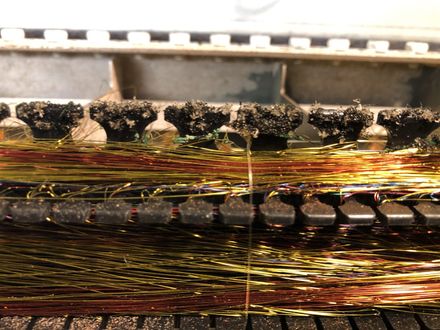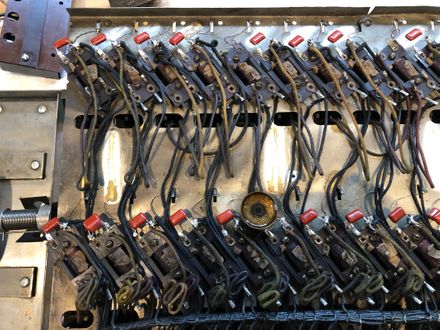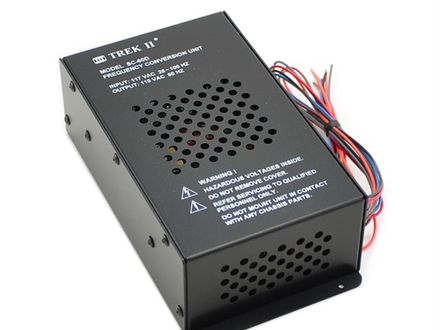Drawbar Dave
Vintage Valve Tonewheel Hammond Organ and Leslie Speaker Specialist. Valve Lowrey Organs, Vintage Keyboards Serviced and Repaired. Custom One Off Builds. Tour Preparation.
Gooey Foam Removal
From 1964 onwards, Hammond used foam strips instead of felt as a dust seal to protect the inside of the manual assemblies. Over time this foam can degrade into a corrosive gooey mess that eats through the tiny resistance wires that connect your key contacts to the generator harness. The foam sits right over the top of the black plastic frame that you can see in the photos. The green substance on the wires shows where the foam residue is gradually eating through the wire. Each tiny damaged wire will have to have the damage cut out and be reconnected. It then has to be coated with a special product to insulate it I then have to check the resistance of every key contact to the terminal strip before I can be satisfied that the manuals can be reinstalled in the organ. This is strictly a workshop only job. No home visits!
On the organ shown in the picture I had to repair 64 resistance wires that were corroded by the gooey foam. The organ now has all of it's tones back and sounds fantastic!
Tone Generator Recapping and Recalibration
Over the years I have been occasionally required to recap a tone generator where the sound of the organ is compromised by lack of treble, hum and excessive crosstalk. In my book, the recapping and recalibration is a last resort after the rebuilding of the organ preamp, Leslie power amp(s) and Leslie crossover have failed to improve things.
117 Volt 60 Cycles to 230 Volt 50 Cycle Conversions (For Imports)
If you are purchasing a tonewheel organ from overseas that runs on 117 volts it will need a stepdown transformer and a frequency converter. I can install both so that your organ will work on UK voltage and be at the correct pitch!
Custom Modifications for Tonewheel Hammonds
This is a selection of mods that I have done for my own collection and for clients (subject to model of Hammond, the below suggestions are based on a 3 series Hammond);
Line Out (with or without level control) Balanced (XLR) line out for hum free long runs to effects or mixer
Bass only line out for further sound reinforcement either to mixer or a sub
Line In to run anything from a Strat to a Rhodes to a Nord through the organ preamp and signal path so eq (if fitted) and reverb etc affect the sound. Volume of aux instrument is not affected by organ swell pedal.
Relay to allow low voltage (with synth footswitch jack) Leslie switching (Also allows up to four different types of Leslie including Neo Vent to be switched simultaneously). You could alternatively have a swell pedal mounted kick switch.
Active tone control (bass and treble boost, gain adjust)
Effects Loop - Add a wah, EQ, Overdrive etc. I like to connect an echo unit here!
Third power switch. If you are using the line in for another instrument through the Leslie and don't want the generator running, this switch just turns on the preamp and Leslie circuits. This is particularly useful in recording studios where you might want to use the Leslie for hours at a time without the hum of the tone generator. One producer friend has a line from his mixing console running through the line in.
Upper manual volume drop mod
Variable chorus mix
Adjustable percussion volume
Leslie combo interfaces
- Takes a speaker level AND line level input (similtaneously if desired)
- Uses a momentary synth footswitch to change speed quietly
- Preamp and tone controls for the line level input
- Available for 122/147/251/9 pin and 11 pin Leslies
My Leslie combo interfaces have been very popular with professional recording studios who want to use the Leslie away from their Hammond and put guitars, synths, electric pianos, vocals or even a aux send from the mixing desk.



